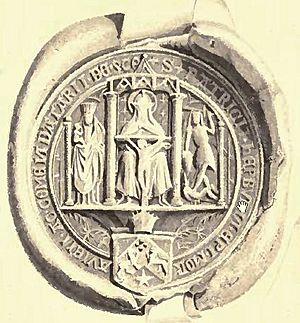Patrick Hepburn facts for kids
Quick facts for kids Patrick Hepburn |
|
|---|---|
| Bishop of Moray | |
 |
|
| See | Diocese of Moray |
| In Office | 1538–1573 |
| Predecessor | Alexander Stewart |
| Successor | George Douglas |
| Orders | |
| Consecration | 1538 |
| Personal details | |
| Born | 1487 Probably East Lothian |
| Died | 20 June 1573 1476, Spynie Castle |
| Previous post | Prior of St Andrews |
Patrick Hepburn (born 1487 – died June 20, 1573) was an important Scottish church leader in the 1500s. He was born in East Lothian, Scotland. He studied at St Andrews University and then joined the church.
Patrick Hepburn used his family's influence to become a powerful figure. He became the Prior of St Andrews and also a royal secretary. Later, he rose to become the Bishop of Moray and the leader of Scone Abbey. He played a complex role during the Scottish Reformation, a big change in Scotland's religious history. He lost his church titles two years before he died in 1573.
Contents
Who Was Patrick Hepburn?
Patrick Hepburn was a significant person in 16th-century Scotland. He was a "prelate," which means a high-ranking church official. He was known for his leadership in the church and his involvement in Scottish politics. His life saw many changes, especially with the rise of the Scottish Reformation.
Early Life and Education
Patrick Hepburn was born in 1487, most likely in East Lothian, a region in Scotland. Not much is known about his very early childhood. However, he went on to study at the University of St Andrews. This was a very important university in Scotland at the time. His education prepared him for a life in the church.
Rising in the Church
After his studies, Patrick Hepburn joined the church. He quickly moved up the ranks. He became the Prior of St Andrews. A prior is the head of a priory, which is a type of monastery. This was a very important position. He also served as a royal secretary, meaning he worked closely with the King of Scotland. These roles gave him a lot of power and influence.
Bishop of Moray
In 1538, Patrick Hepburn became the Bishop of Moray. This made him the leader of the Diocese of Moray, a large church area in northern Scotland. As bishop, he was responsible for many churches and people. He also became the Commendator of Scone. This meant he managed the lands and income of Scone Abbey. He held these important positions for many years.
The Scottish Reformation
Patrick Hepburn lived during a time of great religious change in Scotland. This period is known as the Scottish Reformation. It was a time when many people questioned the traditional church. New ideas about religion, often called Protestantism, became popular. Hepburn played a part in these changes. His role was often complicated, as he tried to navigate the shifting religious landscape.
Later Life and Legacy
Patrick Hepburn continued as Bishop of Moray until near the end of his life. However, he lost his church titles in 1571. This happened two years before he died. He passed away on June 20, 1573, at Spynie Castle. His life shows how powerful church leaders were in Scotland. It also shows the challenges they faced during the Reformation.
Images for kids
-
Armorials at Spynie Castle. Bishop Hepburn's armour is the one on the bottom left.



